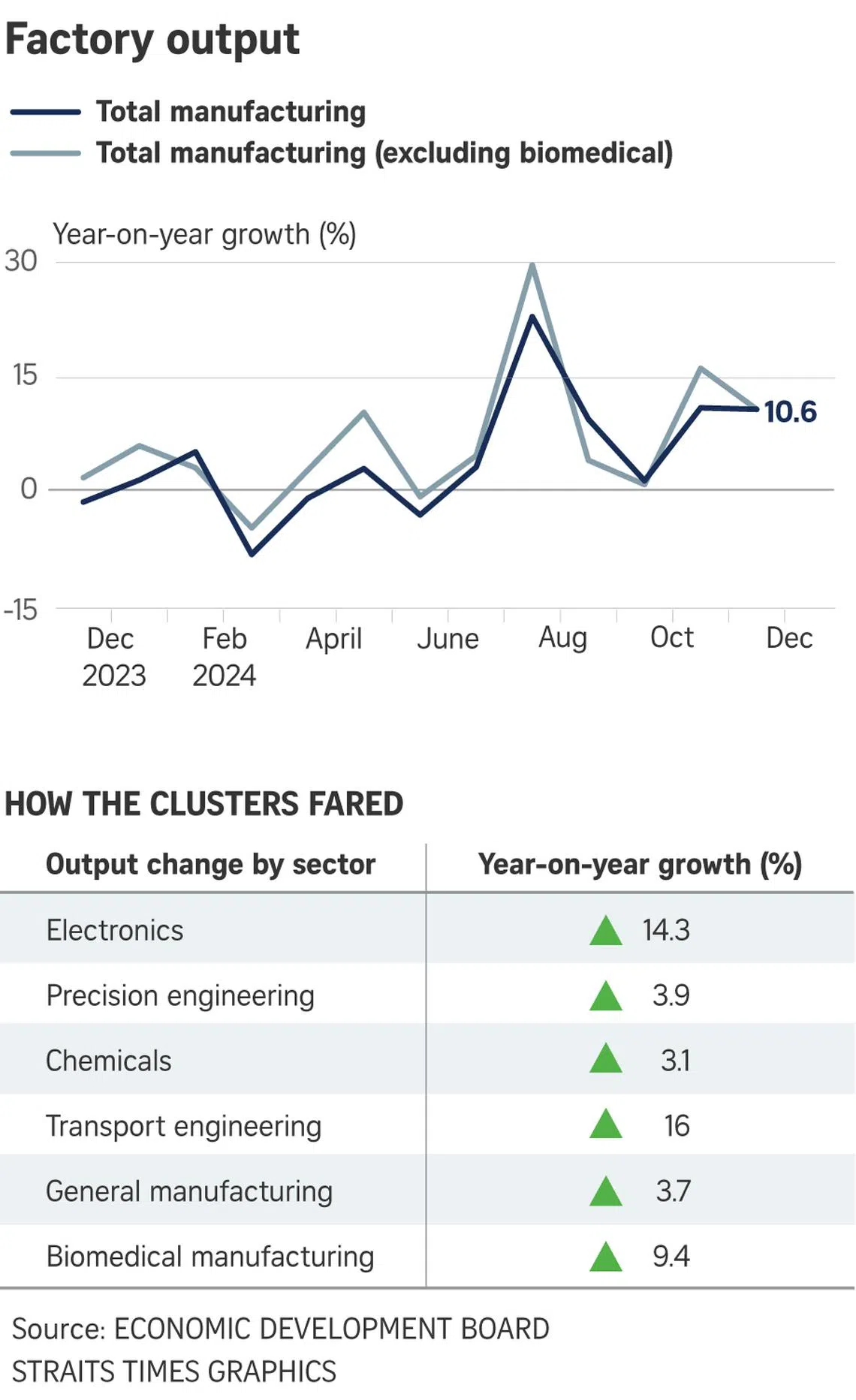Singapore factory output grows 10.6% in December, beating forecasts
Sign up now: Get ST's newsletters delivered to your inbox

Within the electrical cluster, semiconductor production grew 11.4 per cent.
PHOTO: ST FILE
Follow topic:
SINGAPORE – Singapore’s factory production rose for a sixth straight month in December, and analysts said they expect growth to continue, at least for the next few months, on the back of resilient demand for key electronics exports.
Total output expanded 10.6 per cent year on year, after an upwardly revised 10.8 per cent increase in November and a modest 1.2 per cent rise in October.
It beat the 6.2 per cent growth forecast made by analysts in a Bloomberg poll.
Excluding the more volatile biomedical industry, output also increased 10.6 per cent, according to data from the Economic Development Board on Jan 24.
On a seasonally adjusted month-on-month basis, production decreased 0.7 per cent. Excluding biomedical manufacturing, it dropped 5.3 per cent.
The electronics industry, which accounts for nearly half of Singapore’s manufacturing output, saw an increase of 14.3 per cent year on year, lower than the revised 31.3 per cent rise in November.
Within the cluster, semiconductor production grew 11.4 per cent. Other electronic modules and components fell 9.2 per cent, but computer peripherals and data storage expanded 27.1 per cent, and infocomms and consumer electronics surged 41.2 per cent.
DBS Bank economist Chua Han Teng said that Singapore’s positive manufacturing performance in recent months is expected to continue into the first half of 2025.
“Near-term external demand for Singapore’s manufactured goods, particularly electronics, remains resilient,” he added.
“This is observed from the sustained expansion in new export orders of Singapore’s purchasing managers’ indexes, supported by the global tech upcycle.”
Output in the transport engineering sector climbed 16 per cent in December over the same month in 2023.
The marine and offshore engineering segment led the charge, growing 28.1 per cent, supported by a higher level of activity in the shipyards. The aerospace segment grew 10 per cent, recording higher demand for aircraft parts and more maintenance, repair and overhaul jobs from commercial airlines. The land segment also performed well, rising 7.5 per cent.
The chemicals cluster was the worst performer in December but still registered a 3.1 per cent growth over the same month in 2023.
Within the cluster, the “other chemicals segment” rose 18.6 per cent due to a higher output of fragrances. The petroleum segment grew 7.4 per cent, while petrochemicals production increased 6.4 per cent. But the specialities segment plunged 19.8 per cent on account of lower production in mineral oil additives and biofuels.

Biomedical manufacturing output grew 9.4 per cent year on year.
Output in the pharmaceuticals segment rose 13.7 per cent on account of a different mix of active pharmaceutical ingredients being produced. The medical technology segment expanded 10.5 per cent to meet continued export demand for medical devices.
Production in the precision engineering cluster grew 3.9 per cent over the same month in 2023.
Within the cluster, the precision modules and components segment rose 4.6 per cent, with higher production of plastic and metal precision components, as well as electronic connectors.
The machinery and systems segment increased 2.7 per cent, supported by higher production of front-end semiconductor equipment.
General manufacturing output rose 3.7 per cent in December. The food, beverages and tobacco segment expanded 8.9 per cent on the back of higher production of milk powder, cocoa products and animal feed additives.
But the miscellaneous industries declined 0.5 per cent due to lower production of structural metal products and paperboard containers and boxes. The printing segment also saw a drop, falling 6.1 per cent.
DBS’ Mr Chua said that looking ahead, manufacturing may continue to get a boost from the likely front-loading of exports, as companies anticipate potentially higher tariffs under US President Donald Trump.
“But beyond the near term, escalating geopolitical tensions and a more protectionist global trade environment pose medium-term challenges and downside risks to highly trade-dependent Asian economies, including Singapore,” he added.
OCBC Bank chief economist Selena Ling also noted the uncertainty regarding front-loading activities ahead of the anticipated Trump tariffs, including when they might take effect, their scope and the likelihood of retaliatory actions.
She said: “Our forecast for 2025 manufacturing growth is 2.7 per cent year on year, which will be a moderation from the 2024 growth rates of 4.3 per cent.”
Timothy Goh is a business journalist at The Straits Times. He covers private equity, with a focus on start-ups and venture capital.


